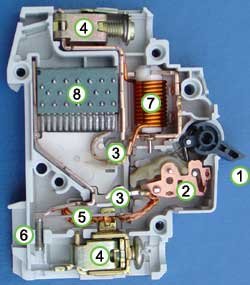|
Source: [email protected] (wikipedia) |
1. Actuator lever – used to manually trip and reset the circuit breaker 2. Actuator mechanism – forces the contacts together or apart 3. Contacts – Allow current when touching and break the current when moved apart 4. Terminals 5. Bimetallic strip 6. Calibration screw – allows the manufacturer to precisely adjust the trip current of the device after assembly 7. Solenoid 8. Arc divider / extinguisher |
Always wondered why DC circuit breakers are/should be used with solar PV systems when AC circuit breakers are less expensive and more readily available?!
Here’s why:
In AC circuits (regular household circuits), the voltage source changes the polarity of its output regularly. In India, this happens 100 times per second. By contrast, in DC circuits, the current flow is unidirectional due to the fixed polarity of the voltage source. This leads to undisrupted, longer and sustainable arcs in DC circuits (the reason why arc welding machines use DC current and not AC current). See DC arcs in action here:
Source: RISE
While breaking a DC circuit, it is easy to form such arcs, and if they are not extinguished in time they lead to device overheating and ultimately to fire. AC circuit breakers are not equipped well enough to deal with such arcs, whereas DC circuit breakers have special arc chutes to capture arcs and extinguish them safely, hence they are highly recommended. See what happens when AC circuit breakers are used in DC circuits or when safety devices are under-rated:
Source: RISE
Learn about more such best practices in the GSES online course Grid Connected PV System Design, or read more in GSES' Grid Connected PV Systems: Design and Installation Handbook. Visit www.gses.in/training or www.gses.in/publications for details.
Follow us on Facebook, Twitter and LinkedIn for more such updates.



